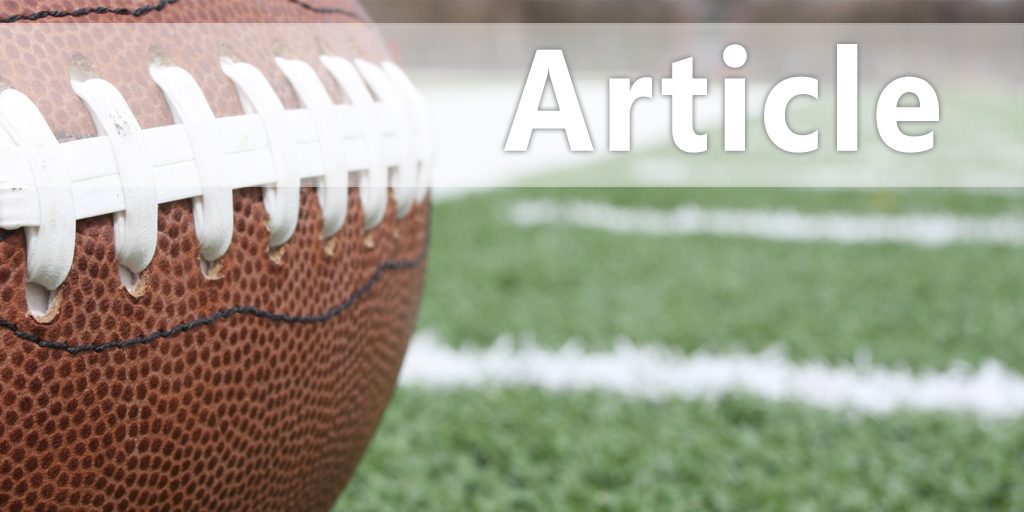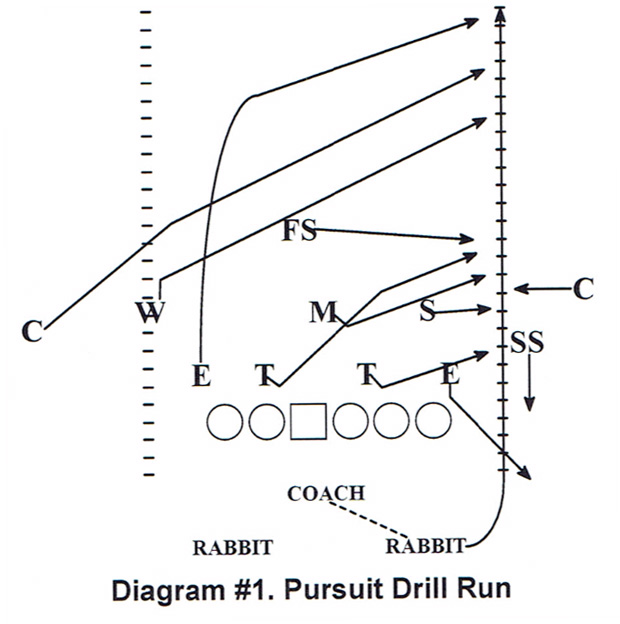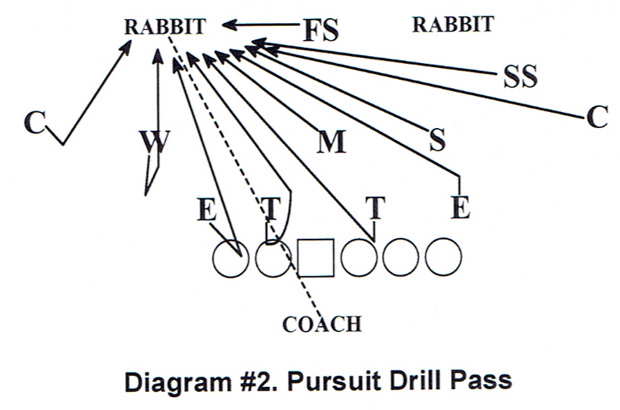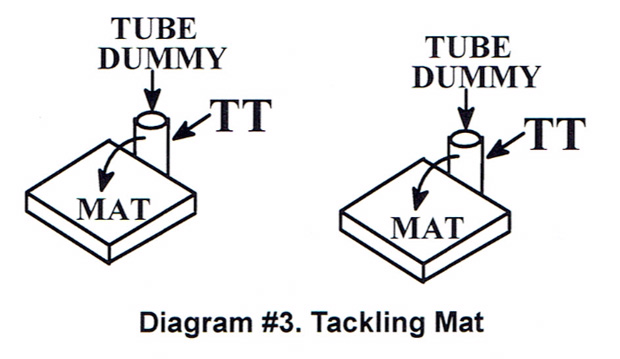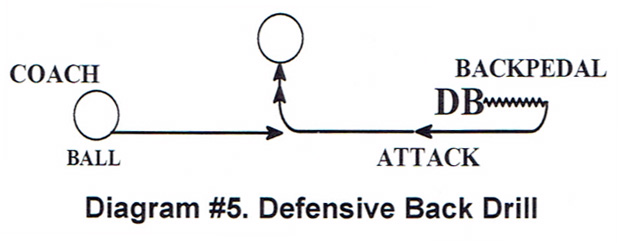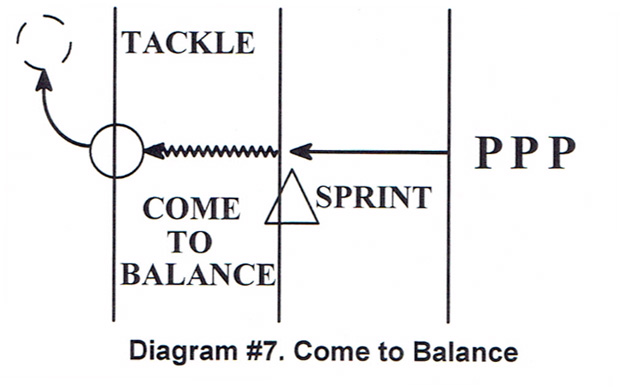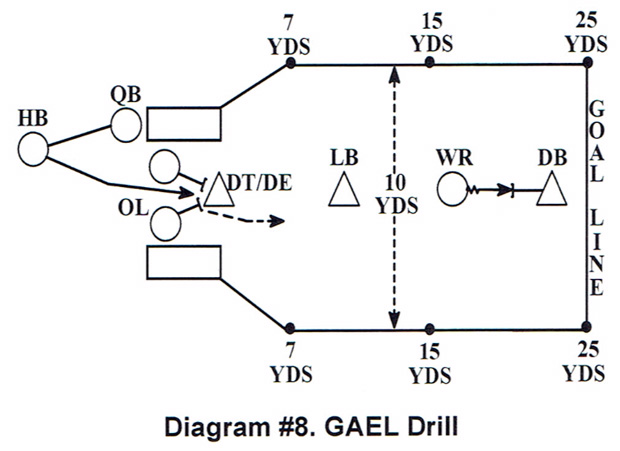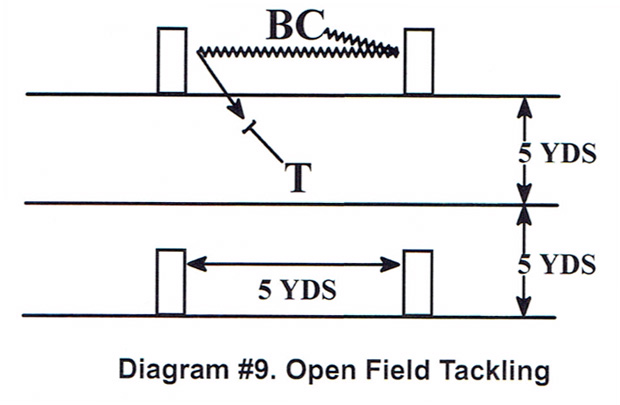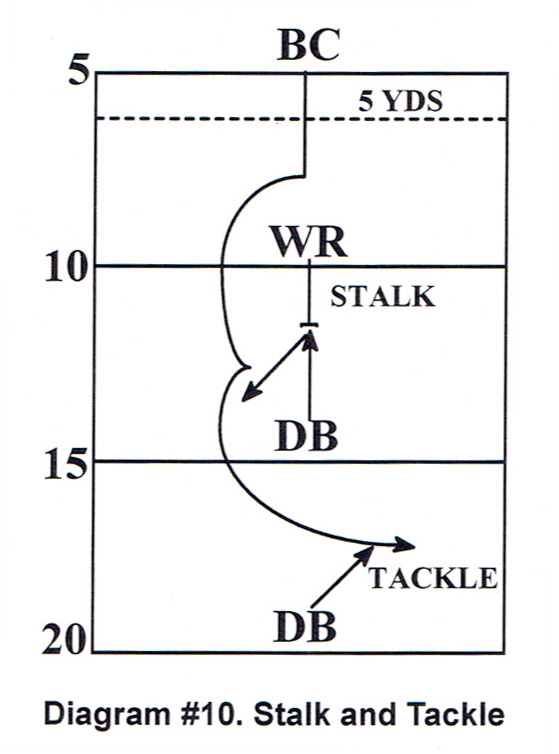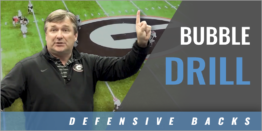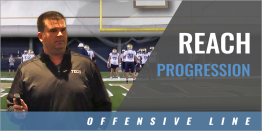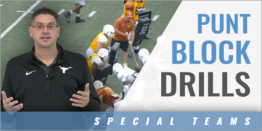| Defensive Drills for a Winning Edge |
| By: Kenny Sanchez - Bishop Gorman High School (NV)
Originally Published in: Nike 2016 Coach of the Year Clinic Notes - by Earl Browning Provided by: Nike Coach of the Year Defensive Success • From the top down 100-percent buy in • Toughness • Alignment, and assignment technique with fantastic effort • Be great at the little things • Do your JOB! • Always in the fight • Weekly goals • Week-to-week emphasis To accomplish those things, you must have something to hang your hat on and create the atmosphere for a winning edge. That starts with a defensive philosophy followed by a means to get it done. Defensive Philosophy • Create the right attitude Pursuit Drill • Proper pursuit angle • Primary and secondary force Fantastic Effort • Hats in the picture frame GAFL Drills • Live tackling • Work defeating blocks at all three levels • Competitive tempo setters • Build toughness We do our pursuit drill all year long. In spring ball we run them every day. We run them in the summer time. During the season we run this once a week. We do not do it so much during the season because we are trying to preserve our legs. Pursuit Drill • Great year round drill • Proper pursuit angles • Discipline (shuffle/scan linebacker, backside defensive end and corner back) • Primary and secondary force • Never chase the same color cloth • Fantastic effort/run to the ball • 9 hats in the picture frame Those are the things we teach in the pursuit drill. The thing you never want to do is get stacked in your pursuit directly behind a teammate. You must be on a different level than other players. Never follow the same color jersey in pursuit. The emphasis in any pursuit drill is to run to the ball. We want to emphasize that fact every time we do the drill. When we do the drill we align the defensive line on large trash cans that represent offensive linemen. (Diagram #1) The defense takes their alignment off the cans.
We have two rabbits in the backfield where the coach stands with a ball. He is going to pitch the ball to one of the rabbits. The rabbit runs outside and down the hash marks on the field. The defense does not impede his running. The defensive end is the first player in the pursuit of the ball. He takes his angle to get outside the ball at the hash mark and turns it back to the inside. The strong safety is the secondary contain and gets into his angle. As the defenders run in their pursuit angle. they want to make sure they are not stacked behind another player in their angle. If they are, they adjust their angle to get out from behind their teammate. The defense is running to the hash marks in their angles. When the last defender reaches the hash mark. the coach blows the whistle and everyone sprints up the hash mark past the line of scrimmage and the next group sprints on the field. We do the same type of drill with the passing game. (Diagram #2) We align the defense on the trash cans. The rabbits are 15 yards down the field standing on the hash marks. The coach drops back and throws the ball to one of the rabbits. The team gets into a pursuit angle to the ball and chops their feet until the whistle blows. When the whistle blows, they turn and sprint back past the line of scrimmage.
In this drill all we are teaching is to run to the ball. We must take proper angles. However. the emphasis is to run to the ball. We do a two-whistle drill in our team drills. The first whistle means the tackle has been made and the offensive teams stops. However, everyone on the defense continues to run to the ball until the second whistle blows. The object is to get everyone to the ball before the second whistle blows. Never give up on getting to the ball. When the defenders arrive at the ball they all chop their feet around the ball carrier. When eve do these drills, we do not spend a lot of practice time on them. We go full speed in the drills and it takes about 5 minutes to get 6-7 repetitions per team. in addition to teaching pursuit, we are working on conditioning. We do not condition at the end of practice. We do all our conditioning in the practice. In this drill they are going to get in about 6-7 30 yard gassers. It is fast and we go one group after the other with not much rest. We do the same thing and emphasize turnovers. The coach retreats and throws the ball to one of the linebackers or defensive backs. Every one breaks on the throw in the direction of the throw. When the ball is intercepted, they all turn and escort him back to the line of scrimmage. When I was coaching in Iowa, I was listening to a football radio show. I think it was Mack Brown. who was the coach of Texas at that time was the guest. He talked about a stupid drill. He had his defensive linemen rusher as the quarterback. When the quarterback threw the ball, the lineman jumped up and batted the ball down. That simply taught them to get their hands up when the quarterback threw the ball. It sounded simple and a little silly, but I did the drill the next week with my players. I could see the improvement in their attacking of the quarterback. It improved their timing on knocking the ball down. That is all we are trying to do in this drill. We are giving the defense a turnover and watching them react to it. Teaching turnovers in practice is hard to do. You must beat up your own players to get it done. We try to create those types of scenarios without beating up our own players. We also do the same thing with a fumbled ball. The coach retreats with the ball and throws it on the ground. We want someone to scoop the ball and score. Every one runs to the ball. someone scoops it up, and everyone escorts the scooper. When we got to Bishop Gorman in 2009, we had 49 players on the varsity squad. This past year we had 77 varsity players. We only have 70 lockers in our locker room. When we go to camp. we may have slightly more than that, but you always have some that quit. If you have a player that comes out as a senior, they very seldom last. When you practice in 120-degree heat, they quickly say screw it and hang it up. We are fortunate now to have a bunch of kids playing football. When we practice, I take three ice chests with wet towels in them to the field. After 45 minutes of practice, we break, they take their pads off, and towel down. We go for one hour and 50 minutes tops in practice. On offense we do an inside period, and 7-on-7 on defense, individual periods, and one other period and we are done for the day. The next day we change the drills and periods but we are not on the field that long. The most we will be on the field during the week will be two hours. We continually water them down during the practice. We do not break for water but it is available whenever they want it. When we teach tackling, we try to tackle without tackling players. (Diagram #3) I went out and bought a tackling pit. It is a padded landing area for tackling drills. We use stand up tube dummies as the ball carrier. The tackler contacts the tube dummies and drives it into the landing pit. You teach the fundamentals of tackling and no one gets hurt. We teach them to bend their knees, strike, wrap up, and drive into the pit.
The thing that is important is the wrap up. You must wrap up the ball carrier and get him to the ground. You can practice that in this tackling drill. You can do the drill without pads and work on all the fundamentals. The difference between this drill and a form tackle is you are getting the feeling of driving a ball carrier to the ground. After the contact with the dummy, you run the feet and plant the ball carrier in the ground. The coaching point is to make the tackler do the fundamentals of tackling. You want them to roll the hips and arch the back. You do not want them picking up the dummy and taking a dive into the pad. The objective is to practice the fundamentals of tackling and not to have a diving drill. After we do the drill with the dummy one yard off the pad, we back the dummy up to three yards off the pad. That makes them make contact on the dummy, wrap, lift, and finish with the drive. Very seldom will you see the perfect form tackle in a football game. When the players tackle, they want to grab cloth somewhere within the tackle. Get a hold on the jersey. The next thing we teach them is the hawk tackle. (Diagram #4) It is the same drill except, we are teaching them to wrap and as they go into the pit, they want to twist and roll with the dummy. This is the tackling drill that teaches you to keep the head out of the tackle. I really like that idea.
The rugby tackling style is great in the open field. However, with defensive linemen and linebackers, the contact occurs in a tight area. The contact is generally high. It is important to keep the head out of the tackle and use the shoulders and chest to secure the tackle. You still have to grab cloth and you cannot get as low, but you must secure the tackle and with safe contact. Linemen can use the twist tackle more effectively than the linebackers. However, in the open field it is a great form of tackling. I think Coach Chris Petersen of Washington is speaking tomorrow and that is the topic he is going to speak on. On an angle tackle, I teach the head across and bite the ball. That keeps the head up and in proper position. The problem with tackling is striking with the head down and using the crown of the head gear. With the emphasis on tackling and concussions you must be careful in what you teach. I have never had an issue with tackling. We teach it safely and emphasize to keep the head out of the tackle. When you tackle your aiming point still has to be from the bottom of the numbers to the top of the knee cap. When you play football, it is impossible to keep the head out of the contact area all the time. That is why you wear a helmet. We had two kids with concussions this year, but that is relative few. We do not want major injuries and we have not had any, knock on wood. I have been coaching for twelve years and in that time I have seen the numbers on tackling. If you look at the NFL. they have a 13-percent rate of concussions. However, that is 86-percent that did not get a concussion. It is like the darn news. they talk about all the bad stuff and forget about the good. The media wants to portray football as being the worst sport ever. When there are so many great things happening in the game. The media wants to point out all the players in college that are getting busted for drugs or sexual abuse and forget about all the other players that are doing the right things and creating positive spins on everything. They go on to graduate from college. get good jobs. and raise families. But the bad characters are getting all the publicity. There are so many more positive stories associated with football than negatives. Are kids going to get hurt. are they going to do drugs, and all that other bad stuff? The answer is yes. However. the great majority of players do not do that. Football is the greatest teacher of life to these kids that there is. I have 180 players in my program. I had two players this year that failed a drug test. But I had 178 players that did not fail the drug test. I do not want to get in trouble for not teaching tackling the correct way. Tackling is part of the game and I am going to teach it. It seems to me people who have never played the game are making the rules. It does not make sense to me. We evaluate what we do all the time. We do not see the need to significantly change what we are doing. A tackling drill we do with defensive backs is the ball drill. (Diagram #5) The coach and players are 10 yards apart. The coach has a big red ball that everyone uses in drills. On the signal the defensive back backpedals for three steps. The coach rolls the big ball toward the defensive back. He reacts and runs forward getting square to the ball. He gets into position to make the tackle on the rolling ball.
That requires him to bend his knees. drop his hips, chop his feet and get ready to tackle. He sweeps the ball with his hands and thrusts it above his head. When he does that his head comes up and he is in a finish position for the tackle. With the ball lifted in front of him. he chops his feet. You can see the movement of the tackler and see the mistakes he makes while trying to elevate the ball. You can see his balance and all the mistakes in fundamentals. They try to go too fast and do not come to balance before grabbing the ball. They are trying to run through the ball without gathering themselves. In the same drill. the coach starts to angle the rolling of the ball instead of throwing it straight to them. This makes them adjust their angle to the ball and get square on the ball. The techniques are the same. They want to grab the ball and thrust it over their head. We progress in the drill by having the coach run at the defender. (Diagram #6) The players reacts and runs at the coach. The coach then rolls the ball to the player's right or left. This is the same drill as the angle roll earlier. The difference is reacting to a ball carrier and changing direction to make the tackle. He has a shorter distance to get ready to scoop the ball and get it over his head.
The next drill is still done with the ball. (Diagram #7) We have the player ten yards from the ball. The player sprints five yards and comes to balance at the cone. The player moves the next five yards in a come to a balance shuffle. He is under control with a good base and chopping his feet as he approaches the ball. When he gets to the ball, he repeats the tackle on the ball. He grabs it and thrusts it over his head.
The next thing we do is a sideline tackling drill. We start the tackler and ball carrier on the numbers. They are ten yards apart. The ball carrier runs to the sidelines at an angle. The tackler does the same thing. Their junction point is five yards from the starting point at the sideline. This is not a live tackling drill. The tackler approaches the ball carrier, comes to balance, and assimilates a tackle. The next part of the drill is the change of direction drill. The ball carrier and tackler do the same thing they did in the angle tackle drill. The difference is when the ball carrier reaches the sideline, he can make one move into the field. The tackler has to come to balance and reposition his head as the ball carrier cuts back to the inside. GAEL Drill (School Mascot — Scottish Highlander - GAEL) • Live tackling • Work at defeating blocks at all 3 levels • Competitive tempo setter • Builds toughness We run the GAEL drill after we get into full gear. (Diagram #8) We cannot get in full gear until two weeks before the first game. When we get in camp, we do this drill a lot. The drill is set up in a five yard wide alley to begin. When we get better at the drill we widen the area. We set cones at 7 yards, 15 yards, and 25 yards. The first cone is the linebacker depth, the second cone is the wide receiver depth and the third cone is the goal line.
In the drill, you have two offensive linemen, a quarterback, and a running back. We have a defensive tackle or end, and a linebacker in the first part of the drill. We work the inside zone play with the blocking scheme. It is a double team block with one blocker coming off on the linebacker. The linebacker aligns 7 yards deep. There is a wide receiver and defensive back in the second part of the drill. The wide receiver is aligned at the 15 yard cone and the defensive back is four yards away from him. They do not participate in the drill unless the running back gets past the linebacker. If he gets past the linebacker, the coach blows a whistle. On the whistle, the wide receiver stalk blocks on the defensive back. The defensive back has to defeat the block and make a tackle on the running back before he scores. There is a ten yard area between the wide receiver and the goal line. In the drill we build excitement and competition between the offensive players and defensive players. The defensive players are along one boundary of the drill and the offensive players are on the other side. If an offensive player tries to run out of bounds, the defensive players shove him back into the drill. The coaches have to be the leaders of the intensity. We want a lot of shouting and yelling. We want the offense cheering for the offense and the defense urging on the defense. We want to build toughness in the drill. It is not organized as to who gets in the drill. The players jump into the drill if they are not called by the coaches. The coaches want to create competitive matchups in the drill and put good players on good players. We do an open field tackling drill. (Diagram #9) The course is a five yard by 10 yard area. The tackler is five yards from the ball carrier. On the first whistle the ball carrier starts to move back and forth between the two bags at the start of the drill. On the second whistle, the ball carrier tries to score. The tackler has to make the tackle in the allotted area. The ball carrier can do anything he wants to try to score. He can fake, move, or try to run over the tackler.
If you look at the distances, the impact area is about two-to-three yards. You are not going to get anyone hurt in that area. The next tackling drill involves a ball carrier and a wide receiver on offense. (Diagram #10) On defense we have two defensive backs. This is a 5 yard by 15 yard box. The ball carrier aligns at the end of the box. There is a wide receiver at 5 yards and a defensive back at 10 yards and one at 15 yards. The wide receiver stalk blocks the first defensive back and the ball carrier tries to score past the second defensive back. Both defensive backs are trying to tackle the ball carrier. One of them has to defeat the stalk block.
This drill is similar to the GAEL drill. However, we are so close in the drill, that no one can build much momentum running. It is a toughness drill like the other ones. In this drill, the blocker can be a fullback or running back. It does not have to be a wide receiver. When we watch game tape, the thing that gets to me more is the lack of effort running to the football. We want players running to the ball and when it goes to the ground, we count to see how many defenders are in the area. I want at least 9 defenders in that frame if it is a running play. In your game film, you can see the defensive linemen coming back down the field after the ball is thrown. They retreat off their pass rush and sprint down the field. You must have that because you never know when the ball will break free. You can tell a lot about your team if the ball breaks and you have to give chase. The ones that are chasing with no chance to catch it are the ones you want to play. They never give up. I appreciate your attention. I was an assistant for a long time. I became the head coach last year and I may not know what the hell I am doing, but I was a great assistant coach. I bought into everything the head coach wanted to do and worked my butt off for him. I was a great position coach because I owned what I did. I was loyal to the head coach and the rest of the coaches on my staff. That is what I have coaching with me now. It works better that way and you can win a lot of games. Thank you so very much and good luck to you. |
